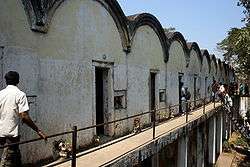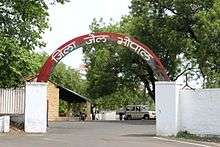Prisons in India
Prisons in India, and their administration, is a state subject covered by item 4 under the State List in the Seventh Schedule of the Constitution of India. The management and administration of prisons falls exclusively in the domain of the State governments, and is governed by the Prisons Act, 1894 and the Prison manuals of the respective state governments. Thus, the states have the primary role, responsibility and authority to change the current prison laws, rules and regulations.[1] The Central Government provides assistance to the states to improve security in prisons, for the repair and renovation of old prisons, medical facilities, development of borstal schools, facilities to women offenders, vocational training, modernization of prison industries, training to prison personnel, and for the creation of high security enclosures.
The Supreme Court of India, in its judgements on various aspects of prison administration, has laid down 3 broad principles regarding imprisonment and custody. Firstly, a person in prison does not become a non-person. Secondly, a person in prison is entitled to all human rights within the limitations of imprisonment. Lastly, there is no justification for aggravating the suffering already inherent in the process of incarceration.
Types of prisons

Prison establishments in India comprise 8 categories of jails. The most common and standard jail institutions are Central Jails, District Jails and Sub Jails. The other types of jail establishments are Women Jails, Borstal Schools, Open Jails and Special Jails.
| Type | Number | Total Capacity[2] |
|---|---|---|
| Central Jails | 134 | 159,158 |
| District Jails | 379 | 137,972 |
| Sub Jails | 741 | 46,368 |
| Women Jails | 18 | 4,748 |
| Open Jails | 63 | 5,370 |
| Borstal Schools | 20 | 1,830 |
| Special Jails | 43 | 10,915 |
| Other Jails | 3 | 420 |
| Total | 1387 | 366,781 |
Central jail
The criteria for a jail to be categorised as a Central Jail varies from state to state. However, the common feature observed throughout India is that prisoners sentenced to imprisonment for a long period (more than 2 years) are confined in the Central Jails, which have larger capacity in comparison to other jails. These jails also have rehabilitation facilities.
Madhya Pradesh has the highest number of 11 Central Jails followed by Maharashtra, Punjab, Rajasthan and Tamil Nadu with 9 each. Karnataka and Delhi each have 8 Central Jails.[3]
Arunachal Pradesh, Meghalaya, Andaman and Nicobar Islands, Dadra and Nagar Haveli, Daman and Diu & Lakshadweep do not have any Central Jails.[3]
District jail
District jails serve as the main prisons in States/UTs where there are no Central Jails.

States which have considerable number of District Jails are Uttar Pradesh(57), Madhya Pradesh(39), Bihar(31), Maharashtra(28), Rajasthan(24), Assam (22), Karnataka (19), Jharkhand (17) and Haryana (16), Kerala (11), West Bengal (12), Chhattisgarh (11), Jammu & Kashmir and Nagaland (10 each).[4]
Sub jail
Sub jails are smaller institutions situated at a sub-divisional level in the States.
9 states have reported comparatively higher number of sub-jails revealing a well-organized prison set-up even at lower formation. These states are Maharashtra (100), Andhra Pradesh (99), Tamil Nadu (96), Madhya Pradesh (72), Karnataka (70), Odisha (73), Rajasthan (60), Telangana and West Bengal (33 each). Odisha had the highest capacity of inmates in various Sub-Jails.[4]
7 States/UTs have no sub-jails namely Arunachal Pradesh, Haryana, Manipur, Meghalaya, Mizoram, Nagaland, Sikkim, Chandigarh and Delhi.[4]
Women's Jail
Jails built to exclusively house women prisoners. Most of the staff in such jails are usually women.
Maharashtra has 5 women jails. Kerala and Tamil Nadu each have 3 women jails.[4]
Borstal School
Borstal Schools are a type of youth detention centre and are used exclusively for the imprisonment of minors or juveniles. The primary objective of Borstal Schools is to ensure care, welfare and rehabilitation of young offenders in an environment suitable for children and keep them away from contaminating atmosphere of the prison. The juveniles in conflict with law detained in Borstal Schools are provided various vocational training and education with the help of trained teachers. The emphasis is given on the education, training and moral influence conducive for their reformation and prevention of crime.
Nine States namely, Himachal Pradesh, Jharkhand, Karnataka, Kerala, Maharashtra, Punjab, Rajasthan, Tamil Nadu and Telangana have borstal schools in their respective jurisdictions.[3] Tamil Nadu had the highest capacity for keeping 678 inmates.[5] Himachal Pradesh and Kerala are the only states that have the capacity to lodge female inmates in 2 of their Borstal Schools.[5] There are no borstal schools in any of the UTs at the end of 2015.
Open jail
Open jails are minimum security prisons. Prisoners with good behaviour satisfying certain norms prescribed in the prison rules are admitted in open prisons. Prisoners, here, are engaged in agricultural activities.
Seventeen states have functioning Open Jails in their jurisdiction. Rajasthan reported the highest number of 29 open jails. There are no Open Jails in any of the UTs at the end of 2015.[4]
Special jail
Special jails are high security facilities that have specialized arrangements for keeping offenders and prisoners who are convicted of terrorism, insurgency and violent crimes. Special jail means any prison provided for the confinement of a particular class or particular classes of prisoners which are broadly as follows:
- Prisoners who have committed serious violations of prison discipline.
- Prisoners showing tendencies towards violence and aggression.
- Difficult discipline cases of habitual offenders.
- Difficult discipline cases from a group of professional/organised criminals.
Kerala has the highest number of special jails - 16. Provision for keeping female prisoners in these special jails is available in Tamil Nadu, West Bengal, Gujarat, Kerala, Assam, Karnataka and Maharashtra.[4]
Other jails
Jails that do not fall into the categories discussed above, fall under the category of Other Jails. Three states - Karnataka, Kerala & Maharashtra - have 1 other jail each in their jurisdiction. No other state/UT has an other jail at the end of 2015.[4]
The capacity of inmates (male & female) reported by these three States in such jails was highest in Karnataka (250) followed by Kerala (142), Goa (45) and Maharashtra (28).[6]
Expenditure
All states and UTs in India had a combined sanctioned budget of ₹42,788.12 million (US$640 million) in 2014-15 for prison related expenditure.[7]
Prison expenditure is broadly categorised as Plan Expenditure and Non-Plan Expenditure. Expenditure on specific planned activities under the Five Year Plan is termed as Plan Expenditure. Expenditure made for meeting day-to-day expenses and running establishments like payment of salaries, wages, rent, etc. come under the Non-Plan Expenditure. Non-Plan Expenditure may also include activities for development of existing infrastructure and bringing about improvements in the prisons.
Expenditure on prison inmates is categorised as Food, Clothing, Medical, Vocational/Educational facilities, Welfare and Other expenses. Food expenses account for more than half the total expenditure on prison inmates.
Prison population statistics
As of 31 December 2014, there are 1387 functioning jails in India having a total capacity to house 356,561 prisoners. As of the same date, there were 418,536 inmates in jails across in India. Males at 400,855 make up 95.8% of prisoners while females at 17,681 represent 4.2%.
Types of prison inmates
Prison inmates lodged in Indian jails are categorised as Convicts, Under-trials and Detenues. A convict is "a person found guilty of a crime and sentenced by a court" or "a person serving a sentence in prison".[8] An under-trial is a person who is currently on trial in a court of law.[9] A detenue is any person held in custody.[10][11]
Prison inmates lodged in Indian jails in relation to non-Indian Penal Code (IPC) crimes are classified as civil prisoners. They consist of Convicts and Under-trials.
Population
The following table gives the population and occupancy rate of prisons in India annually:
| Year | No. of Inmates | Occupancy Rate[lower-alpha 1] | ||
|---|---|---|---|---|
| Male | Female | Total | ||
| 2009 | 122.8% | |||
| 2010 | 115.1% | |||
| 2011 | 356,902 | 16,024 | 372,926 | 112.1% |
| 2012 | 368,184 | 16,951 | 385,135 | 112.2% |
| 2013[12] | 393,804 | 18,188 | 411,992 | 118.4% |
| 2014[13] | 400,855 | 17,681 | 418,536 | 117.4% |
See also
Prison officers ranks:
- Inspector General of Prisons
- Deputy Inspector General of Prisons
- Assistant Inspector General of Prisons
- Superintendent of Jail
Related:
List:
Notes
- ↑ Occupancy Rate means number of inmates staying in jails against the authorized capacity for 100 inmates.
References
- ↑ "India - The Penal System". Country-data.com. Retrieved 4 June 2013.
- ↑ "National Crime Records Bureau - Prison Statistics" (PDF). ncrb.gov.in.
- 1 2 3 "Prison Statistics India 2014" (PDF). ncrb.gov.in. Retrieved 26 July 2016.
- 1 2 3 4 5 6 7 "PRISON STATISTICS INDIA 2015". ncrb.nic.in. Retrieved 2016-11-08.
- 1 2 "Prison Statistics India" (PDF). National Crime Records Bureau. Retrieved 26 July 2016.
- ↑ "Prison Statistics India 2014" (PDF). National Crime Records Bureau. 2014. Retrieved 26 July 2016.
- ↑ "Prison Statistics India 2014" (PDF). National Crime Records Bureau. 2014. Retrieved 26 July 2016.
- ↑ Webster's New World Dictionary of the American Language, p. 311 (2d Coll. Ed. 1978).
- ↑ "Definition of undertrial in Oxford Dictionaries (British & World English)". Oxforddictionaries.com. 29 May 2013. Retrieved 4 June 2013.
- ↑ "Definition of detenu in Oxford Dictionaries (British & World English)". Oxforddictionaries.com. 29 May 2013. Retrieved 4 June 2013.
- ↑ "Détenu - Definition and More from the Free Merriam-Webster Dictionary". Merriam-webster.com. Retrieved 4 June 2013.
- ↑ http://ncrb.nic.in/StatPublications/PSI/Prison2013/Snapshots-2013.pdf
- ↑ "Prison Statistics India 2014" (PDF). National Crime Records Bureau. Retrieved 26 July 2016.
External links
- http://ncrb.gov.in/StatPublications/PSI/Prison2014/PrisonStat2014rev1.htm
- http://ncrb.gov.in/StatPublications/PSI/Prison2014/ContTab.htm